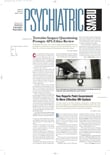When patients taking Novartis's Clozaril were switched to a generic clozapine, no statistically significant changes were seen in a wide array of outcomes measuring patient stability and resource utilization, according to a study published in the August Community Mental Health Journal.
Concerns about the bioequivalence of generic and brand-name clozapine have existed nearly as long as the generic versions of the second-generation antipsychotic have been available. The first generic version of Clozaril was approved by the U.S. Food and Drug Administration (FDA) on November 26, 1997. Within roughly a year, clinicians were expressing concerns that that first generic, made by Zenith-Goldline Pharmaceuticals, was not, in fact, bioequivalent to the brand-name product. There were numerous reports of patients whose symptoms became worse and even some reports of full relapse after being switched from the branded product to the generic.
The issue became so heated that Novartis and Ivax Corp. (which makes the Zenith-Goldline brand of generic products) threatened reciprocal legal action in 2000 (Psychiatric News, December 15, 2000). By February 2001, the FDA publicly stated that the data the agency had seen indicated there was no bioequivalence problem. The FDA also said, however, that it would continue to monitor reports of bioequivalence problems and recommended that Ivax conduct a new complete bioequivalence study. Ivax subsequently did so, and the FDA confirmed the drug's AB bioequivalence rating to Clozaril.
“These data demonstrate that there was no increase in service utilization by patients converted to generic clozapine.”
The latest study, completed by Daniel Healy, M.D., a clinical assistant professor of psychiatry at the University of Michigan, and his colleagues, looked at 108 adult patients aged 18 and above in a clozapine clinic at the Washtenaw County Community Mental Health Center (CMHC) in Michigan. These 108 patients constituted all the patients being followed in the clozapine clinic at the time.
In an attempt to reduce pharmaceutical costs, the CMHC, along with the University of Michigan Pharmacy Service, decided to switch patients from Clozaril to a specific generic equivalent, made by Mylan Pharmaceuticals. The CMHC chose Mylan, the researchers noted, because of the company's strong data on bioequivalence.
For each patient, serum clozapine levels were obtained two weeks before and after the switch from brand to generic. A one-year retrospective examination of each patient's records was completed prior to the switch.
Information about outpatient psychiatric visits, emergency room visits, inpatient hospitalizations, partial-hospital or day-program utilization, crisis-center utilization, dose of clozapine, and use of any adjunct antipsychotic medications were collected for each patient. The same information was collected for one year following the patients' switch to clozapine.
Of the 108 patients, 62 were men and 46 women, and the average age was 42.5 years. The patient sample was overwhelmingly Caucasian; only two were Hispanic, and 14 African American. The average daily dose of Clozaril taken by patients prior to the switch was 452 mg (+/- 177 mg). The average dose of clozapine after the switch was 451 mg (=/- 176 mg). No statistically significant differences were found in serum blood levels achieved with oral doses of clozapine compared with Clozaril.
In the year after the switch, 16 patients required an increase in dose, and 11 required a decrease in dose. Nine patients required the addition of an adjunct antipsychotic, and three patients who were already on a second antipsychotic had to be changed to a different antipsychotic.
Overall, there were no statistically significant differences between Novartis's Clozaril and Mylan's clozapine as measured by inpatient hospital days, crisis-center utilization, admissions for inpatient treatment, and outpatient psychiatric visits for the periods studied—that is, one year before the switch and one year after the switch. The only statistically significant finding was a decrease in psychiatric emergency room visits—69 for Clozaril compared with 32 for clozapine.
“These data demonstrate that there was no increase in service utilization by patients converted to generic clozapine. In fact, all of our measures of utilization decreased, although the decrease was significant only for ER visits,” the authors concluded.
Healy and his colleagues suggested that the lack of increase in service utilization and the significant decline of ER use “may reflect gradual stabilization of these patients over time or the gradual reductions of patients using inpatient or psychiatric emergency room services in general.”
The switch, they added, “was cost-effective, as the reduction in pharmacy costs was not offset by increased utilization costs.”
The researchers conceded that they used “proxy measures of utilization” that “did not reflect increasing symptoms.” The researchers also noted that because patients' clinical status was not assessed before and after the switch, “it is possible that patients did exhibit symptom change with the switch.”
An abstract of “Clinical Equivalence of Generic Clozapine” can be accessed at<springerlink.metapress.com> by clicking on “Browse Publications,” “C,”“ Community Mental Health Journal,” and“ August.” ▪
